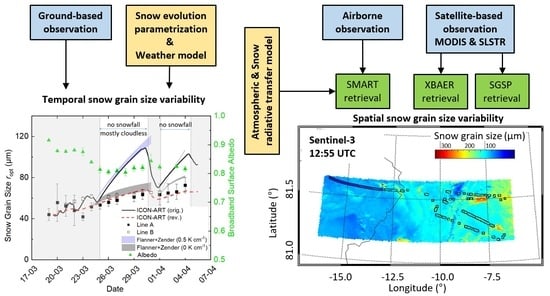Measurements and Modeling of Optical-Equivalent Snow Grain Sizes under Arctic Low-Sun Conditions
Abstract
:1. Introduction
2. Study Area and Measurements
2.1. PAMARCMiP Campaign
2.2. Instrumentation to Measure the Snow Grain Size
2.2.1. Ground-Based Measurements by the IceCube System
2.2.2. Airborne Measurements by SMART
2.2.3. Satellite Measurements
2.3. Measurement Conditions during PAMARCMiP 2018
2.3.1. Sea Ice Conditions
2.3.2. Meteorological Conditions
3. Modeling Tools and Retrieval Methods
3.1. Overview
3.2. Models
3.2.1. Snow Radiative Transfer Model—TARTES
3.2.2. Atmospheric Radiative Transfer Model—libRadtran
3.2.3. Weather and Climate Model—ICON-ART
3.2.4. Parametrization of SSA Evolution
3.3. Snow Grain Size Retrieval Methods
3.3.1. XBAER Retrieval of Snow Grain Size Using Satellite-Based Sentinel-3 Data
3.3.2. SGSP Retrieval of Snow Grain Size Using Satellite-Based MODIS Data
3.3.3. Snow Grain Size Retrieval Using Airborne SMART Data
3.3.4. Relevance of Atmospheric Effect Correction on SMART Retrieval
4. Comparison of Retrieval Results
4.1. Temporal Variability: Local Observations and Modeling
4.2. Spatial Variability: Airborne and Satellite Observations
4.2.1. Retrieved Maps of Snow Grain Size
4.2.2. Statistical Comparison for Smooth Snow Surfaces
5. Discussion: Implications of Low-Sun Conditions
5.1. Uncertainties of the SGSP Satellite Retrieval
5.2. SMART Measurement Uncertainty and Retrieval Sensitivity
5.3. Effect of Snow Particle Shape
5.4. Wavelength Choice and Penetration Depth
6. Summary and Conclusions
Author Contributions
Funding
Data Availability Statement
Acknowledgments
Conflicts of Interest
References
- Serreze, M.C.; Barry, R.G. Processes and impacts of Arctic amplification: A research synthesis. Glob. Planet. Chang. 2011, 77, 85–96. [Google Scholar] [CrossRef]
- Cohen, J.; Screen, J.A.; Furtado, J.C.; Barlow, M.; Whittleston, D.; Coumou, D.; Francis, J.; Dethloff, K.; Entekhabi, D.; Overland, J.; et al. Recent Arctic amplification and extreme mid-latitude weather. Nat. Geosci. 2014, 7, 627–637. [Google Scholar] [CrossRef] [Green Version]
- Wendisch, M.; Macke, A.; Ehrlich, A.; Lüpkes, C.; Mech, M.; Chechin, D.; Dethloff, K.; Velasco, C.B.; Bozem, H.; Brückner, M.; et al. The Arctic Cloud Puzzle: Using ACLOUD/PASCAL Multiplatform Observations to Unravel the Role of Clouds and Aerosol Particles in Arctic Amplification. Bull. Am. Meteorol. Soc. 2019, 100, 841–871. [Google Scholar] [CrossRef]
- Pithan, F.; Mauritsen, T. Arctic amplification dominated by temperature feedbacks in contemporary climate models. Nature 2014, 7, 181–184. [Google Scholar] [CrossRef]
- Qu, X.; Hall, A. On the persistent spread in snow-albedo feedback. Clim. Dyn. 2014, 42, 69–81. [Google Scholar] [CrossRef]
- Fletcher, C.G.; Thackeray, C.W.; Burgers, T.M. Evaluating biases in simulated snow albedo feedback in two generations of climate models. J. Geophys. Res. 2015, 120, 12–26. [Google Scholar] [CrossRef]
- Goosse, H.; Kay, J.E.; Armour, K.C.; Bodas-Salcedo, A.; Chepfer, H.; Docquier, D.; Jonko, A.; Kushner, P.J.; Lecomte, O.; Massonnet, F.; et al. Quantifying climate feedbacks in polar regions. Nat. Commun. 2018, 9, 1919. [Google Scholar] [CrossRef] [PubMed]
- Block, K.; Schneider, F.A.; Mülmenstädt, J.; Salzmann, M.; Quaas, J. Climate models disagree on the sign of total radiative feedback in the Arctic. Tellus A Dyn. Meteorol. Oceanogr. 2020, 72, 1–14. [Google Scholar] [CrossRef] [Green Version]
- Taylor, K.E.; Stouffer, R.J.; Meehl, G.A. An Overview of CMIP5 and the Experiment Design. Bull. Am. Meteorol. Soc. 2012, 93, 485–498. [Google Scholar] [CrossRef] [Green Version]
- Choudhury, B.J.; Chang, A.T.C. The albedo of snow for partially cloudy skies. Bound.-Layer Meteor. 1981, 20, 371–389. [Google Scholar] [CrossRef]
- Warren, S. Optical Properties of Snow. Rev. Geophys. Space Phys. 1982, 20, 67–89. [Google Scholar] [CrossRef]
- Warren, S.; Brandt, R.; O’Rawe Hinton, P. Effect of surface roughness on bidirectional reflectance of Antarctic snow. J. Geophys. Res. 1998, 103, 25789–25807. [Google Scholar] [CrossRef]
- Dumont, M.; Brissaud, O.; Picard, G.; Schmitt, B.; Gallet, J.C.; Arnaud, Y. High-accuracy measurements of snow Bidirectional Reflectance Distribution Function at visible and NIR wavelengths—Comparison with modelling results. Atmos. Chem. Phys. 2010, 10, 2507–2520. [Google Scholar] [CrossRef] [Green Version]
- Gardner, A.S.; Sharp, M.J. A review of snow and ice albedo and the development of a new physically based broadband albedo parameterization. J. Geophys. Res. Earth Surf. 2010, 115, 1–15. [Google Scholar] [CrossRef]
- Pirazzini, R.; Raisanen, P.; Vihma, T.; Johansson, M.; Tastula, E.M. Measurements and modelling of snow particle size and shortwave infrared albedo over a melting Antarctic ice sheet. Cryosphere 2015, 9, 2357–2381. [Google Scholar] [CrossRef] [Green Version]
- Saito, M.; Yang, P.; Loeb, N.G.; Kato, S. A Novel Parameterization of Snow Albedo Based on a Two-Layer Snow Model with a Mixture of Grain Habits. J. Atmos. Sci. 2019, 76, 1419–1436. [Google Scholar] [CrossRef]
- Tanikawa, T.; Kuchiki, K.; Aoki, T.; Ishimoto, H.; Hachikubo, A.; Niwano, M.; Hosaka, M.; Matoba, S.; Kodama, Y.; Iwata, Y.; et al. Effects of Snow Grain Shape and Mixing State of Snow Impurity on Retrieval of Snow Physical Parameters From Ground-Based Optical Instrument. J. Geophys. Res. Atmos. 2020, 125, e2019JD031858. [Google Scholar] [CrossRef]
- Larue, F.; Picard, G.; Arnaud, L.; Ollivier, I.; Delcourt, C.; Lamare, M.; Tuzet, F.; Revuelto, J.; Dumont, M. Snow albedo sensitivity to macroscopic surface roughness using a new ray-tracing model. Cryosphere 2020, 14, 1651–1672. [Google Scholar] [CrossRef]
- Donth, T.; Jäkel, E.; Ehrlich, A.; Heinold, B.; Schacht, J.; Herber, A.; Zanatta, M.; Wendisch, M. Combining atmospheric and snow radiative transfer models to assess the solar radiative effects of black carbon in the Arctic. Atmos. Chem. Phys. 2020, 20, 8139–8156. [Google Scholar] [CrossRef]
- Colbeck, S.C. Theory of metamorphism of dry snow. J. Geophys. Res. Ocean. 1983, 88, 5475–5482. [Google Scholar] [CrossRef]
- Gubler, H. Model for dry snow metamorphism by interparticle vapor flux. J. Geophys. Res. Atmos. 1985, 90, 8081–8092. [Google Scholar] [CrossRef]
- Taillandier, A.S.; Domine, F.; Simpson, W.R.; Sturm, M.; Douglas, T.A. Rate of decrease of the specific surface area of dry snow: Isothermal and temperature gradient conditions. J. Geophys. Res. Earth Surf. 2007, 112, F3. [Google Scholar] [CrossRef] [Green Version]
- Kaempfer, T.U.; Schneebeli, M. Observation of isothermal metamorphism of new snow and interpretation as a sintering process. J. Geophys. Res. Atmos. 2007, 112, 24101. [Google Scholar] [CrossRef]
- Kikuchi, K.; Kameda, T.; Higuchi, K.; Yamashita, A. A global classification of snow crystals, ice crystals, and solid precipitation based on observations from middle latitudes to polar regions. Atmos. Res. 2013, 132, 460–472. [Google Scholar] [CrossRef]
- Grenfell, T.C.; Warren, S.G. Representation of a nonspherical ice particle by a collection of independent spheres for scattering and absorption of radiation. J. Geophys. Res. 1999, 104, 31697–31709. [Google Scholar] [CrossRef]
- Neshyba, S.P.; Grenfell, T.C.; Warren, S.G. Representation of a nonspherical ice particle by a collection of independent spheres for scattering and absorption of radiation: 2. Hexagonal columns and plates. J. Geophys. Res. 2003, 108, 4448. [Google Scholar] [CrossRef]
- Fily, G.P.L.A.F.D.M. Determining snow specific surface area from near-infrared reflectance measurements: Numerical study of the influence of grain shape. Cold Reg. Sci. Technol. 2009, 56, 10–17. [Google Scholar] [CrossRef]
- Libois, Q.; Picard, G.; Arnaud, L.; Dumont, M.; Lafaysse, M.; Morin, S.; Lefebvre, E. Summertime evolution of snow specific surface area close to the surface on the Antarctic Plateau. Cryosphere 2015, 9, 2383–2398. [Google Scholar] [CrossRef] [Green Version]
- Picard, G.; Libois, Q.; Arnaud, L.; Verin, G.; Dumont, M. Development and calibration of an automatic spectral albedometer to estimate near-surface snow SSA time series. Cryosphere 2016, 10, 1297–1316. [Google Scholar] [CrossRef] [Green Version]
- Carlsen, T.; Birnbaum, G.; Ehrlich, A.; Freitag, J.; Heygster, G.; Istomina, L.; Kipfstuhl, S.; Orsi, A.; Schäfer, M.; Wendisch, M. Comparison of different methods to retrieve optical-equivalent snow grain size in central Antarctica. Cryosphere 2017, 11, 2727–2741. [Google Scholar] [CrossRef] [Green Version]
- Dumont, M.; Arnaud, L.; Picard, G.; Libois, Q.; Lejeune, Y.; Nabat, P.; Voisin, D.; Morin, S. In situ continuous visible and near-infrared spectroscopy of an alpine snowpack. Cryosphere 2017, 11, 1091–1110. [Google Scholar] [CrossRef] [Green Version]
- Jin, Z.; Charlock, T.P.; Yang, P.; Xie, Y.; Miller, W. Snow optical properties for different particle shapes with application to snow grain size retrieval and MODIS/CERES radiance comparison over Antarctica. Remote Sens. Environ. 2008, 112, 3563–3581. [Google Scholar] [CrossRef]
- Lyapustin, A.; Tedesco, M.; Wang, Y.; Aoki, T.; Hori, M.; Kokhanovsky, A. Retrieval of snow grain size over Greenland from MODIS. Remote Sens. Environ. 2009, 113, 1976–1987. [Google Scholar] [CrossRef]
- Retrieval of subpixel snow covered area, grain size, and albedo from MODIS. Remote Sens. Environ. 2009, 113, 868–879. [CrossRef] [Green Version]
- Zege, E.P.; Katsev, I.L.; Malinka, A.V.; Prikhach, A.S.; Heygster, G.; Wiebe, H. Algorithm for retrieval of the effective snow grain size and pollution amount from satellite measurements. Remote Sens. Environ. 2011, 115, 2674–2685. [Google Scholar] [CrossRef]
- Kokhanovsky, A.; Lamare, M.; Danne, O.; Brockmann, C.; Dumont, M.; Picard, G.; Arnaud, L.; Favier, V.; Jourdain, B.; Le Meur, E.; et al. Retrieval of Snow Properties from the Sentinel-3 Ocean and Land Colour Instrument. Remote Sens. 2019, 11, 2280. [Google Scholar] [CrossRef] [Green Version]
- Mei, L.; Rozanov, V.; Pohl, C.; Vountas, M.; Burrows, J.P. The retrieval of snow properties from SLSTR Sentinel-3—Part 1: Method description and sensitivity study. Cryosphere 2021, 15, 2757–2780. [Google Scholar] [CrossRef]
- Gallet, J.C.; Domine, F.; Zender, C.S.; Picard, G. Measurement of the specific surface area of snow using infrared reflectance in an integrating sphere at 1310 and 1550 nm. Cryosphere 2009, 3, 167–182. [Google Scholar] [CrossRef] [Green Version]
- Mei, L.; Rozanov, V.; Jäkel, E.; Cheng, X.; Vountas, M.; Burrows, J.P. The retrieval of snow properties from SLSTR Sentinel-3—Part 2: Results and validation. Cryosphere 2021, 15, 2781–2802. [Google Scholar] [CrossRef]
- Wiebe, H.; Heygster, G.; Zege, E.; Aoki, T.; Hori, M. Snow grain size retrieval SGSP from optical satellite data: Validation with ground measurements and detection of snow fall events. Remote Sens. Environ. 2013, 128, 11–20. [Google Scholar] [CrossRef]
- Kokhanovsky, A.A.; Zege, E.P. Scattering optics of snow. Appl. Opt. 2004, 43, 1589–1602. [Google Scholar] [CrossRef]
- Kuchiki, K.; Aoki, T.; Niwano, M.; Motoyoshi, H.; Iwabuchi, H. Effect of sastrugi on snow bidirectional reflectance and its application to MODIS data. J. Geophys. Res. Atmos. 2011, 116, D18110. [Google Scholar] [CrossRef] [Green Version]
- Libois, Q.; Picard, G.; France, J.L.; Arnaud, L.; Dumont, M.; Carmagnola, C.M.; King, M.D. Influence of grain shape on light penetration in snow. Cryosphere 2013, 7, 1803–1818. [Google Scholar] [CrossRef] [Green Version]
- Flanner, M.G.; Zender, C.S. Linking snowpack microphysics and albedo evolution. J. Geophys. Res. 2006, 111, D12208. [Google Scholar] [CrossRef] [Green Version]
- Herber, A.B.; Haas, C.; Stone, R.S.; Bottenheim, J.W.; Liu, P.; Li, S.M.; Staebler, R.M.; Strapp, J.W.; Dethloff, K. Regular airborne surveys of Arctic sea ice and atmosphere. Eos Trans. Am. Geophys. Union 2012, 93, 41–42. [Google Scholar] [CrossRef]
- Wesche, C.; Steinhage, D.; Nixdorf, U. Polar aircraft Polar5 and Polar6 operated by the Alfred Wegener Institute. J. Large-Scale Res. Facil. 2016, 2, A87. [Google Scholar] [CrossRef] [Green Version]
- Nakoudi, K.; Ritter, C.; Böckmann, C.; Kunkel, D.; Eppers, O.; Rozanov, V.; Mei, L.; Pefanis, V.; Jäkel, E.; Herber, A.; et al. Does the Intra-Arctic Modification of Long-Range Transported Aerosol Affect the Local Radiative Budget? (A Case Study). Remote Sens. 2020, 12, 2112. [Google Scholar] [CrossRef]
- Wendisch, M.; Heintzenberg, J.; Bussemer, M. Measurement-based aerosol forcing calculations: The influence of model complexity. Meteor. Z. 2001, 10, 45–60. [Google Scholar] [CrossRef]
- Carlsen, T.; Birnbaum, G.; Ehrlich, A.; Helm, V.; Jäkel, E.; Schäfer, M.; Wendisch, M. Parameterizing anisotropic reflectance of snow surfaces from airborne digital camera observations in Antarctica. Cryosphere 2020, 14, 3959–3978. [Google Scholar] [CrossRef]
- Ikonen, I.; Demetriades, N.W.S.; Holle, R. Vaisala dropsondes: History, status, and applications. In Proceedings of the 29th Conference on Hurricanes and Tropical Meteorology, SPONSOR, Tucson, AZ, USA, 10–14 May 2010. [Google Scholar]
- Herber, A.; Thomason, L.W.; Gernandt, H.; Leiterer, U.; Nagel, D.; Schulz, K.H.; Kaptur, J.; Albrecht, T.; Notholt, J. Continuous day and night aerosol optical depth observations in the Arctic between 1991 and 1999. J. Geophys. Res. 2002, 107, AAC 6-1–AAC 6-13. [Google Scholar] [CrossRef]
- Stachlewska, I.S.; Neuber, R.; Lapmpert, A.; Ritter, C.; Wehrle, G. AMALi—the Airborne Mobile Aerosol Lidar for Arctic research. Atmos. Chem. Phys. 2010, 10, 2947–2963. [Google Scholar] [CrossRef] [Green Version]
- Calonne, N.; Richter, B.; Löwe, H.; Cetti, C.; ter Schure, J.; Van Herwijnen, A.; Fierz, C.; Jaggi, M.; Schneebeli, M. The RHOSSA campaign: Multi-resolution monitoring of the seasonal evolution of the structure and mechanical stability of an alpine snowpack. Cryosphere 2020, 14, 1829–1848. [Google Scholar] [CrossRef]
- Bierwirth, E.; Wendisch, M.; Ehrlich, A.; Heese, B.; Tesche, M.; Althausen, D.; Schladitz, A.; Müller, D.; Otto, S.; Trautmann, T.; et al. Spectral surface albedo over Morocco and its impact on the radiative forcing of Saharan dust. Tellus 2009, 61B, 252–269. [Google Scholar] [CrossRef] [Green Version]
- Jäkel, E.; Walther, J.; Wendisch, M. Thermodynamic phase retrieval of convective clouds: Impact of sensor viewing geometry and vertical distribution of cloud properties. Atmos. Meas. Tech. 2013, 6, 539–547. [Google Scholar] [CrossRef] [Green Version]
- Coppo, P.; Ricciarelli, B.; Brandani, F.; Delderfield, J.; Ferlet, M.; Mutlow, C.; Munro, G.; Nightingale, T.; Smith, D.; Bianchi, S.; et al. SLSTR: A high accuracy dual scan temperature radiometer for sea and land surface monitoring from space. J. Mod. Opt. 2010, 57, 1815–1830. [Google Scholar] [CrossRef]
- Spreen, G.; Kaleschke, L.; Heygster, G. Sea ice remote sensing using AMSR-E 89 GHz channels. J. Geophys. Res. 2008, 113, C02S03. [Google Scholar] [CrossRef] [Green Version]
- Rostosky, P.; Spreen, G.; Farrell, S.L.; Frost, T.; Heygster, G.; Melsheimer, C. Snow Depth Retrieval on Arctic Sea Ice From Passive Microwave Radiometers—Improvements and Extensions to Multiyear Ice Using Lower Frequencies. J. Geophys. Res. Ocean. 2018, 123, 7120–7138. [Google Scholar] [CrossRef]
- Angström, A. The parameters of atmospheric turbidity. Tellus 1964, 16, 64–75. [Google Scholar] [CrossRef] [Green Version]
- Joseph, J.; Wiscombe, W.; Weinman, J. The Delta-Eddington Approximation for Radiative Flux Transfer. J. Atmos. Sci. 1977, 33, 2452–2459. [Google Scholar] [CrossRef]
- Libois, Q.; Picard, G.; Dumont, M.; Arnaud, L.; Sergent, C.; Pougatch, E.; Sudul, M.; Vial, D. Experimental determination of the absorption enhancement parameter of snow. J. Glaciol. 2014, 60, 714–724. [Google Scholar] [CrossRef] [Green Version]
- Mayer, B.; Kylling, A. Technical note: The libRadtran software package for radiative transfer calculations—Description and examples of use. Atmos. Chem. Phys. 2005, 5, 1855–1877. [Google Scholar] [CrossRef] [Green Version]
- Emde, C.; Buras-Schnell, R.; Kylling, A.; Mayer, B.; Gasteiger, J.; Hamann, U.; Kylling, J.; Richter, B.; Pause, C.; Dowling, T.; et al. The libRadtran software package for radiative transfer calculations (version 2.0.1). Geosci. Model Dev. 2016, 9, 1647–1672. [Google Scholar] [CrossRef] [Green Version]
- Stamnes, K.; Tsay, S.C.; Wiscombe, W.; Laszlo, I. DISORT, A General-Purpose Fortran Program for Discrete-Ordinate-Method Radiative Transfer in Scattering and Emitting Layered Media: Documentation of Methodology; Technical Report; Deptartment of Physics and Engineering Physics, Stevens Institute of Technology: Hoboken, NJ, USA, 2000. [Google Scholar]
- Ricchiazzi, P.; Gautier, C. Investigation of the effect of surface heterogeneity and topography on the radiation environment of Palmer Station, Antarctica, with a hybrid 3-D radiative transfer model. J. Geophys. Res. 1998, 103, 6161–6178. [Google Scholar] [CrossRef] [Green Version]
- Gueymard, C.A. The sun’s total and spectral irradiance for solar energy applications and solar radiation models. Sol. Energy 2004, 76, 423–453. [Google Scholar] [CrossRef]
- Zängl, G.; Reinert, D.; Ripodas, P.; Baldauf, M. The ICON (ICOsahedral Non-hydrostatic) modelling framework of DWD and MPI-M: Description of the non-hydrostatic dynamical core. Q. J. R. Meteorol. Soc. 2015, 141, 563–579. [Google Scholar] [CrossRef]
- Giorgetta, M.A.; Brokopf, R.; Crueger, T.; Esch, M.; Fiedler, S.; Helmert, J.; Hohenegger, C.; Kornblueh, L.; Köhler, M.; Manzini, E.; et al. ICON-A, the Atmosphere Component of the ICON Earth System Model: I. Model Description. J. Adv. Model. Earth Syst. 2018, 10, 1613–1637. [Google Scholar] [CrossRef]
- Rieger, D.; Bangert, M.; Bischoff-Gauss, I.; Förstner, J.; Lundgren, K.; Reinert, D.; Schröter, J.; Vogel, H.; Zängl, G.; Ruhnke, R.; et al. ICON–ART 1.0—A new online-coupled model system from the global to regional scale. Geosci. Model Dev. 2015, 8, 1659–1676. [Google Scholar] [CrossRef] [Green Version]
- Schröter, J.; Rieger, D.; Stassen, C.; Vogel, H.; Weimer, M.; Werchner, S.; Förstner, J.; Prill, F.; Reinert, D.; Zängl, G.; et al. ICON-ART 2.1—A flexible tracer framework and its application for composition studies in numerical weather forecasting and climate simulations. Geosci. Model Dev. Discuss. 2018, 11, 4043–4068. [Google Scholar] [CrossRef] [Green Version]
- Machulskaya, E.E.; Lykosov, V.N. An Advanced Snow Parameterization for Models of Atmospheric Circulation. COSMO Newsl. 2008, 8, 10–16. [Google Scholar]
- Essery, R.; Best, M.; Cox, P. MOSES 2.2 Technical Documentation, Hadley Centre Technical Note 30. 2001, p. 30. Available online: https://jules.jchmr.org/sites/default/files/HCTN_30.pdf (accessed on 22 September 2021).
- Legagneux, L.; Taillandier, A.S.; Dominé, F. Grain growth theories and the isothermal evolution of the specific surface area of snow. J. Appl. Phys. 2004, 95, 6175–6184. [Google Scholar] [CrossRef]
- Mei, L.; Rozanov, V.; Vountas, M.; Burrows, J.P.; Levy, R.C.; Lotz, W. Retrieval of aerosol optical properties using MERIS observations: Algorithm and some first results. Remote Sens. Environ. 2017, 197, 125–140. [Google Scholar] [CrossRef] [PubMed]
- Mei, L.; Rozanov, V.; Vountas, M.; Burrows, J.P. The retrieval of ice cloud parameters from multi-spectral satellite observations of reflectance using a modified XBAER algorithm. Remote Sens. Environ. 2018, 215, 128–144. [Google Scholar] [CrossRef]
- Mei, L.; Rozanov, V.; Ritter, C.; Heinold, B.; Jiao, Z.; Vountas, M.; Burrows, J.P. Retrieval of Aerosol Optical Thickness in the Arctic Snow-Covered Regions Using Passive Remote Sensing: Impact of Aerosol Typing and Surface Reflection Model. IEEE Trans. Geosci. Remote Sens. 2020, 58, 5117–5131. [Google Scholar] [CrossRef]
- Yang, P.; Bi, L.; Baum, B.A.; Liou, K.N.; Kattawar, G.W.; Mishchenko, M.I.; Cole, B. Spectrall consistent scattering, absorption, and polarization properties of atmospheric ice crystals at wavelengths from 0.2 to 100 μm. J. Atmos. Sci. 2013, 70, 330–347. [Google Scholar] [CrossRef]
- Kokhanovsky, A.A. The influence of horizontal inhomogeneity on radiative characteristics of clouds: An asymptotic case study. IEEE Trans. Geosci. Remote Sens. 2003, 41, 817–825. [Google Scholar] [CrossRef]
- Warren, S.G.; Brandt, R.E. Optical constants of ice from the ultraviolet to the microwave: A revised compilation. J. Geophys. Res. 2008, 113, D14220. [Google Scholar] [CrossRef]
- Kokhanovsky, A.; Macke, A. Integral light-scattering and absorption characteristics of large, nonspherical particles. Appl. Opt. 1997, 36, 8785–8790. [Google Scholar] [CrossRef] [PubMed]
- Wendisch, M.; Pilewskie, P.; Jäkel, E.; Schmidt, S.; Pommier, J.; Howard, S.; Jonsson, H.H.; Guan, H.; Schröder, M.; Mayer, B. Airborne measurements of areal spectral surface albedo over different sea and land surfaces. J. Geophys. Res. 2004, 109, D08203. [Google Scholar] [CrossRef]
- Jäkel, E.; Stapf, J.; Wendisch, M.; Nicolaus, M.; Dorn, W.; Rinke, A. Validation of the sea ice surface albedo scheme of the regional climate model HIRHAM–NAOSIM using aircraft measurements during the ACLOUD/PASCAL campaigns. Cryosphere 2019, 13, 1695–1708. [Google Scholar] [CrossRef] [Green Version]
- Hartmann, M.; Adachi, K.; Eppers, O.; Haas, C.; Herber, A.; Holzinger, R.; Hünerbein, A.; Jäkel, E.; Jentzsch, C.; van Pinxteren, M.; et al. Wintertime Airborne Measurements of Ice Nucleating Particles in the High Arctic: A Hint to a Marine, Biogenic Source for Ice Nucleating Particles. Geophys. Res. Lett. 2020, 47, e2020GL087770. [Google Scholar] [CrossRef]
- Hudson, S.R.; Warren, S.G.; Brandt, R.E.; Grenfell, T.C.; Six, D. Spectral bidirectional reflectance of Antarctic snow: Measurements and parameterization. J. Geophys. Res. Atmos. 2006, 111, D18106. [Google Scholar] [CrossRef] [Green Version]
- Zege, E.; Ivanov, A.; Katsev, I. Image Transfer through a Scattering Medium; Springer: New York, NY, USA, 1991. [Google Scholar]
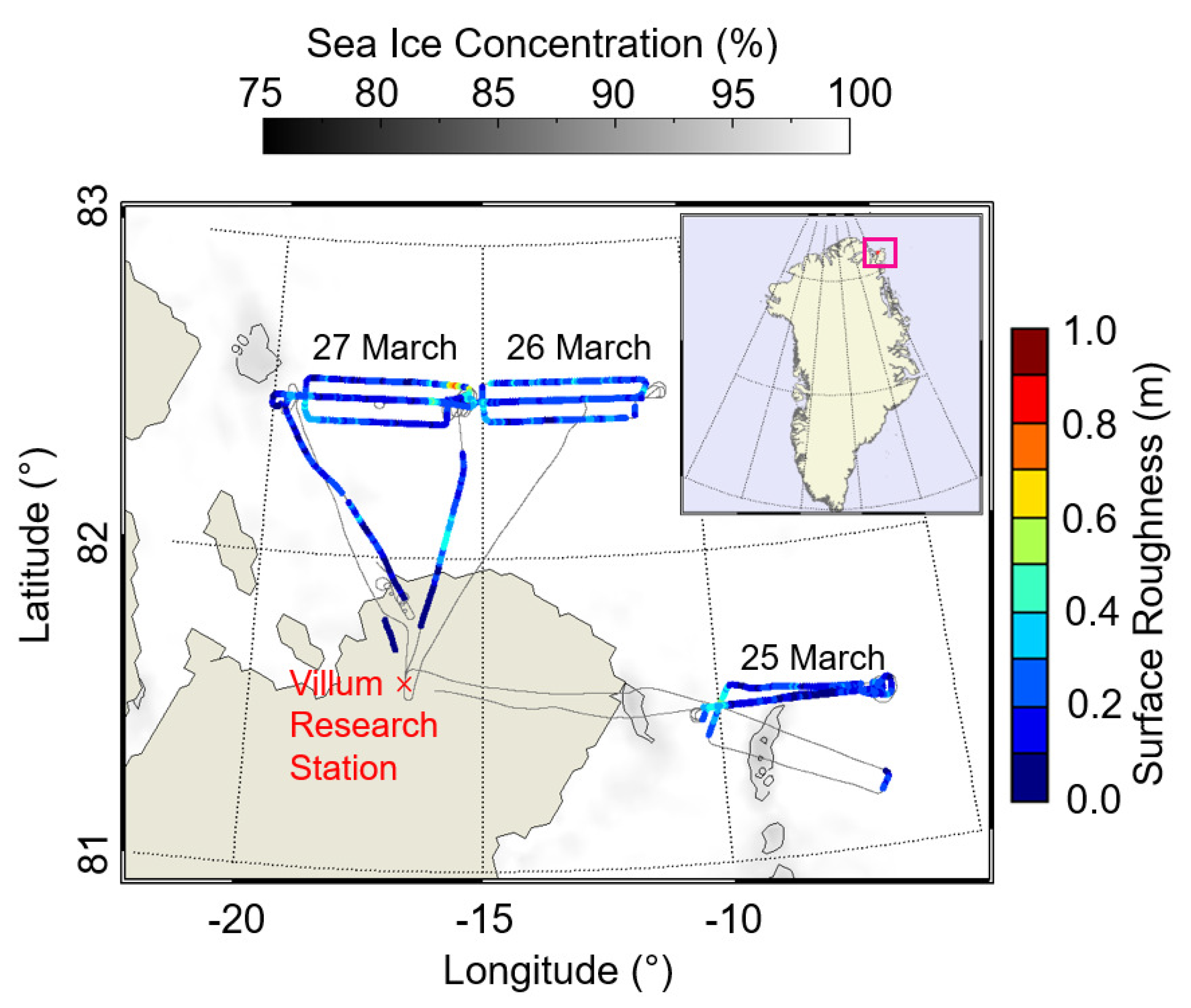
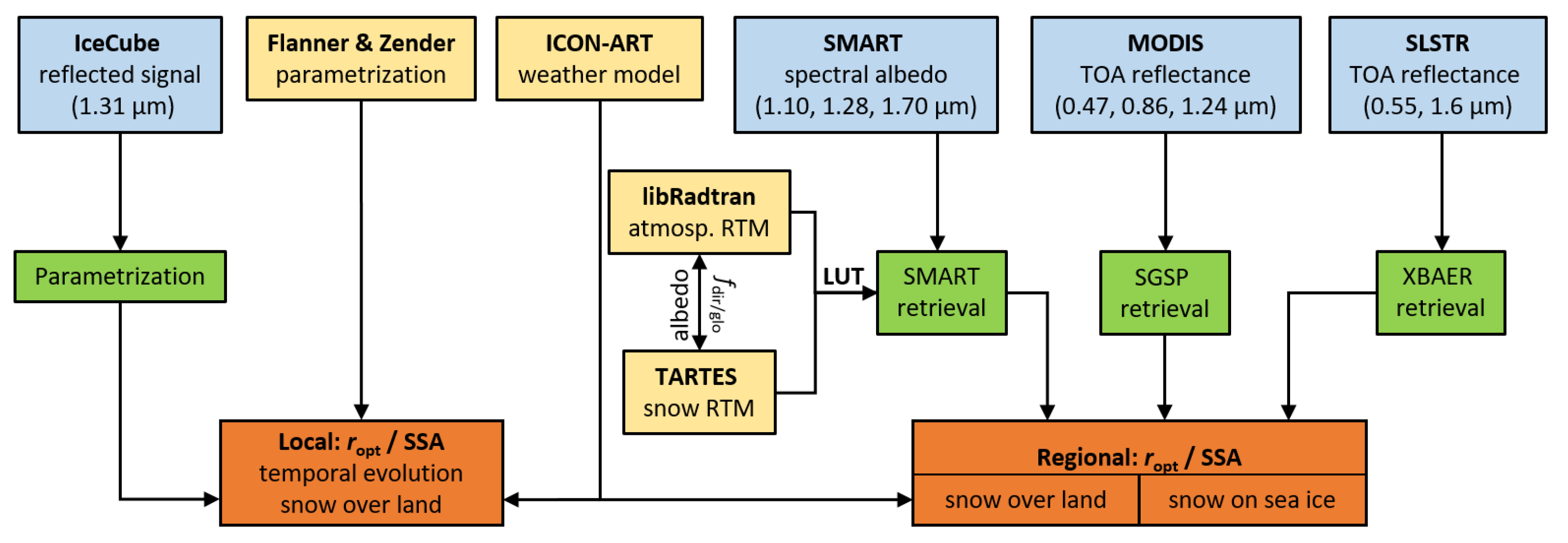
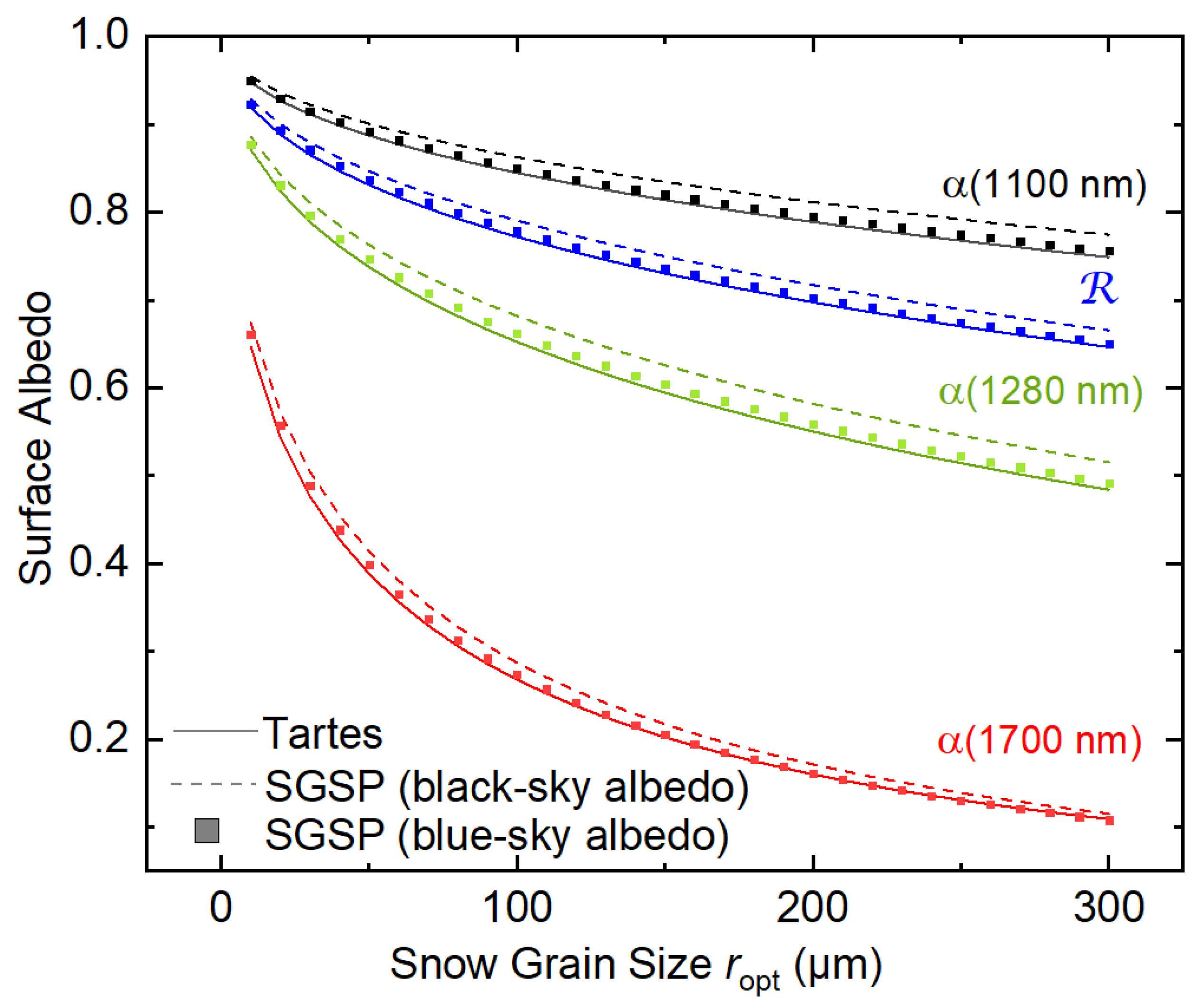

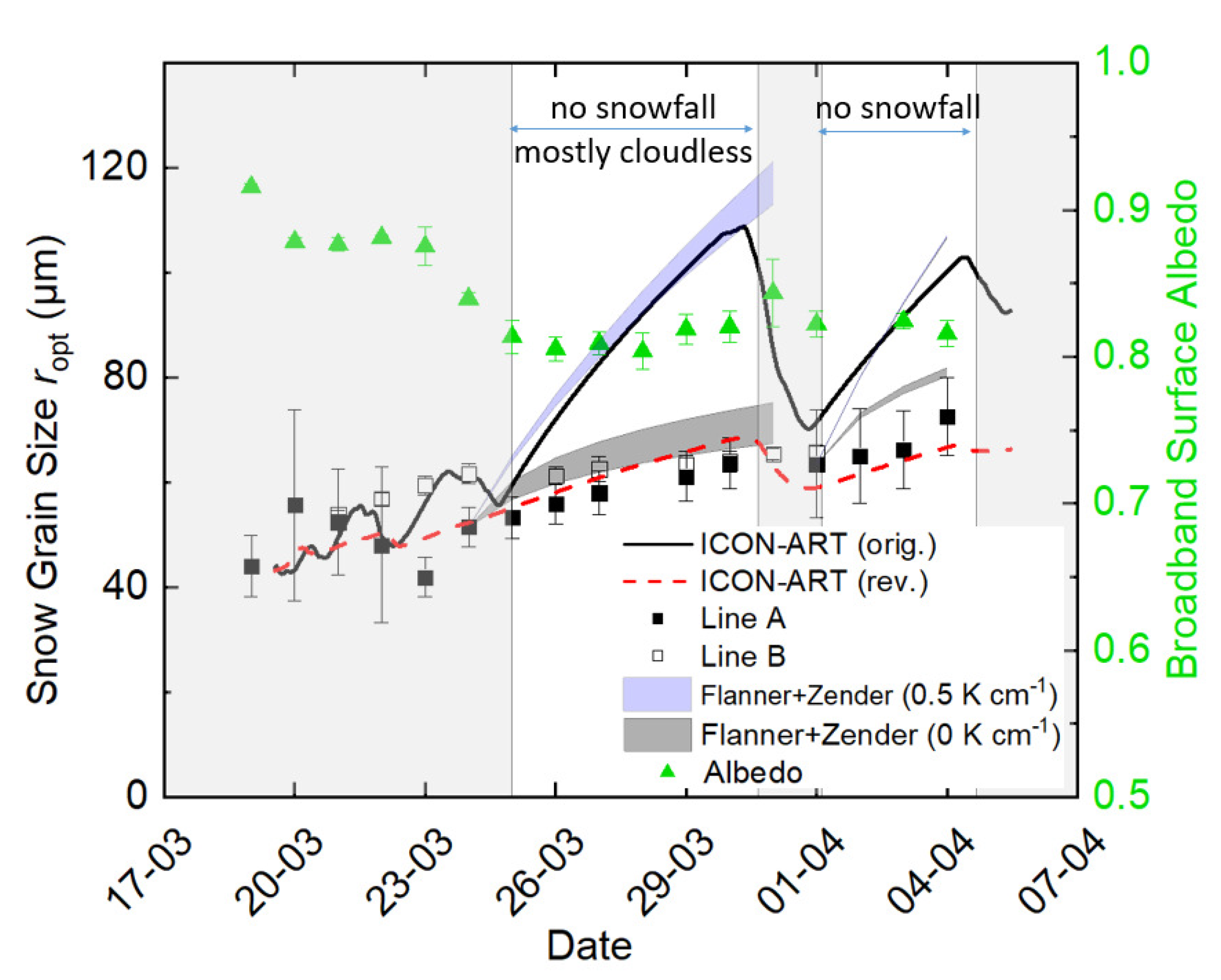
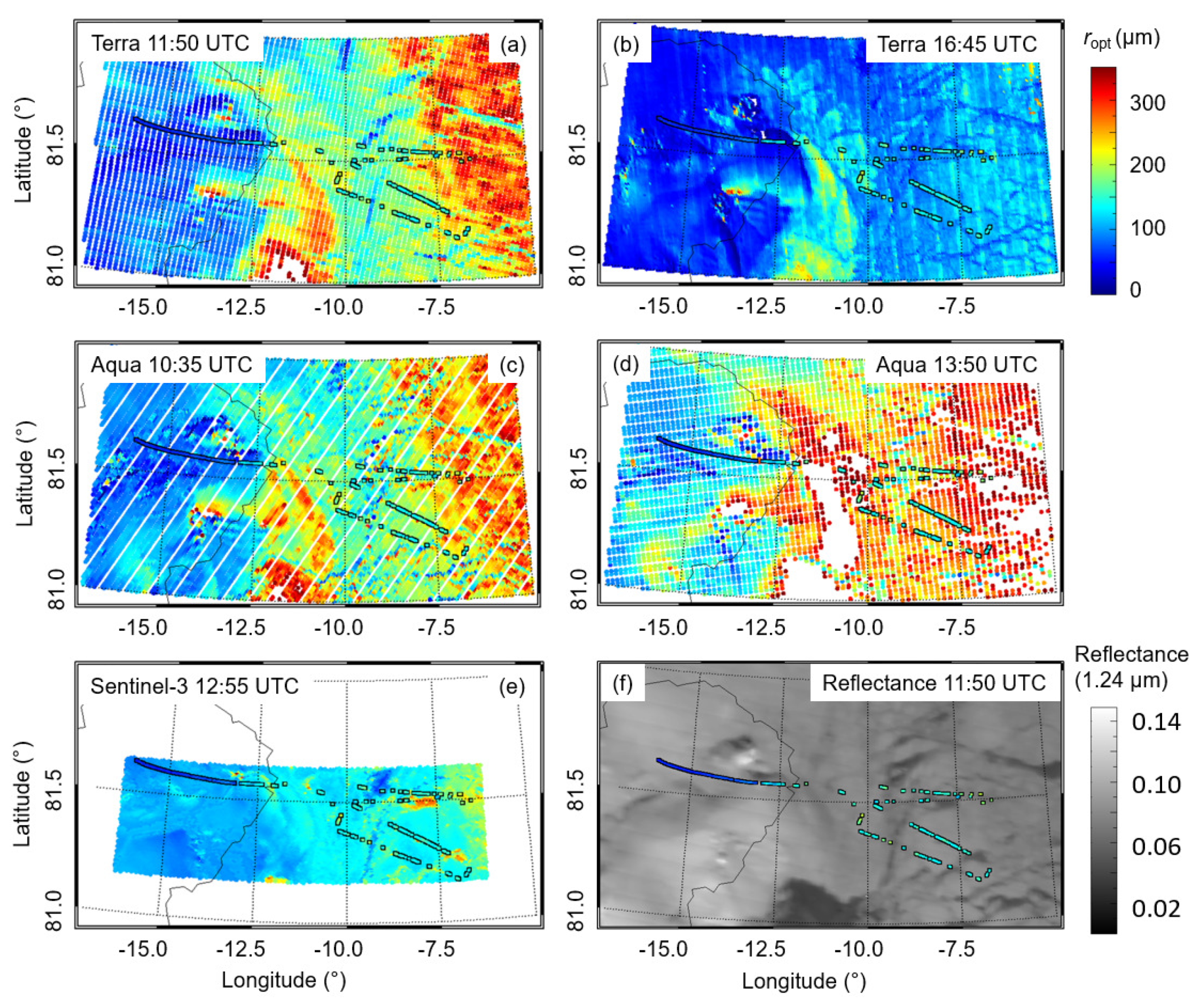
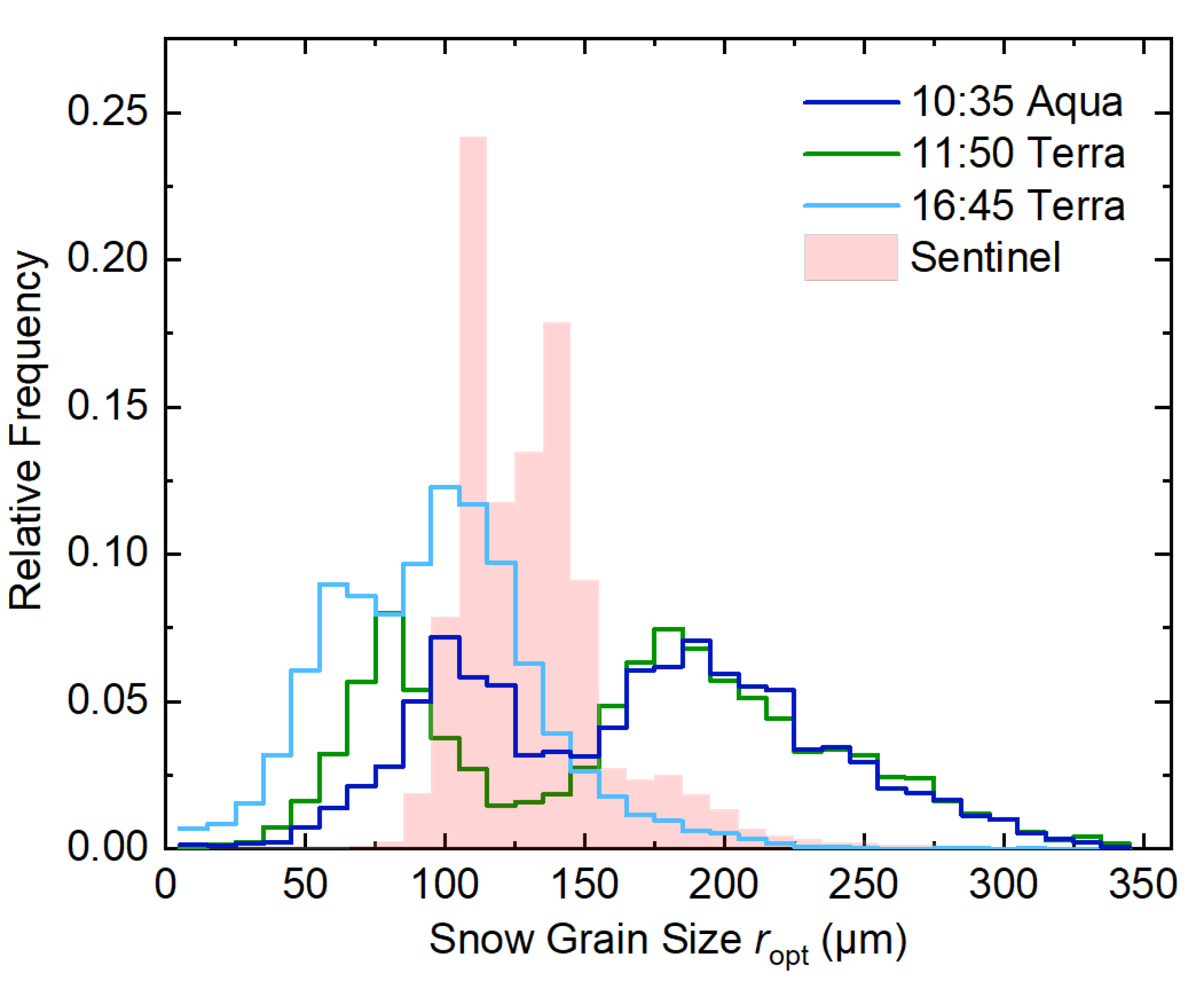
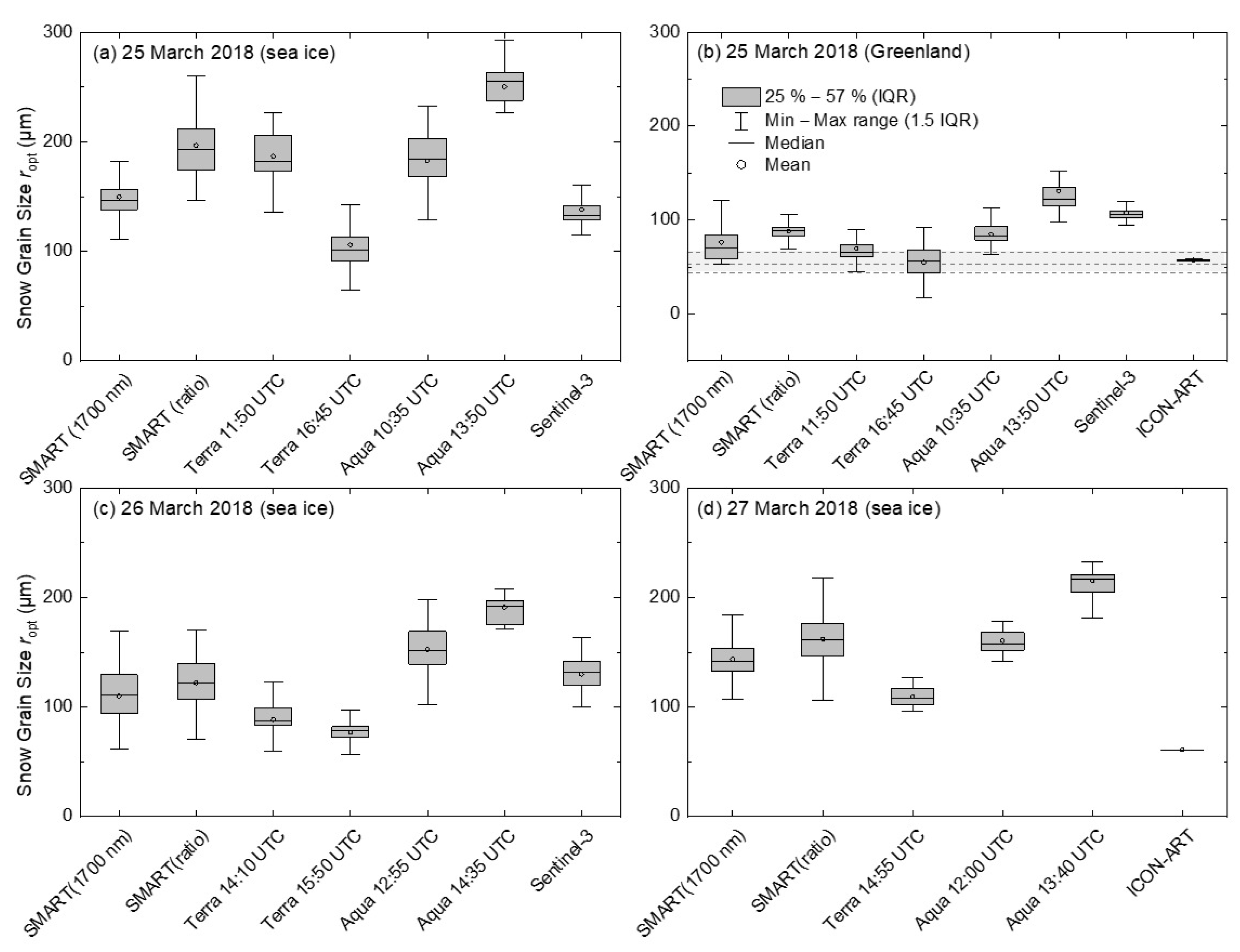
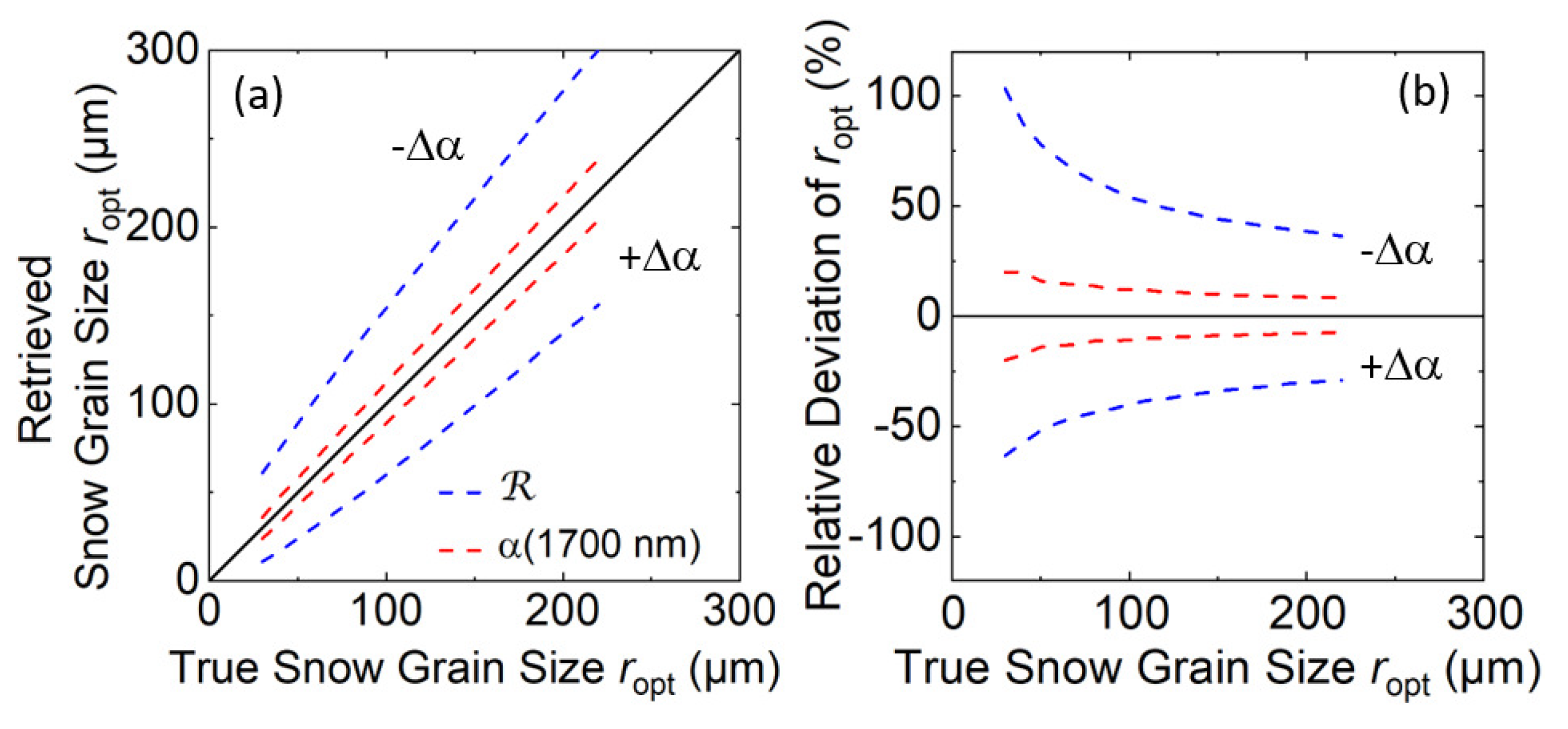
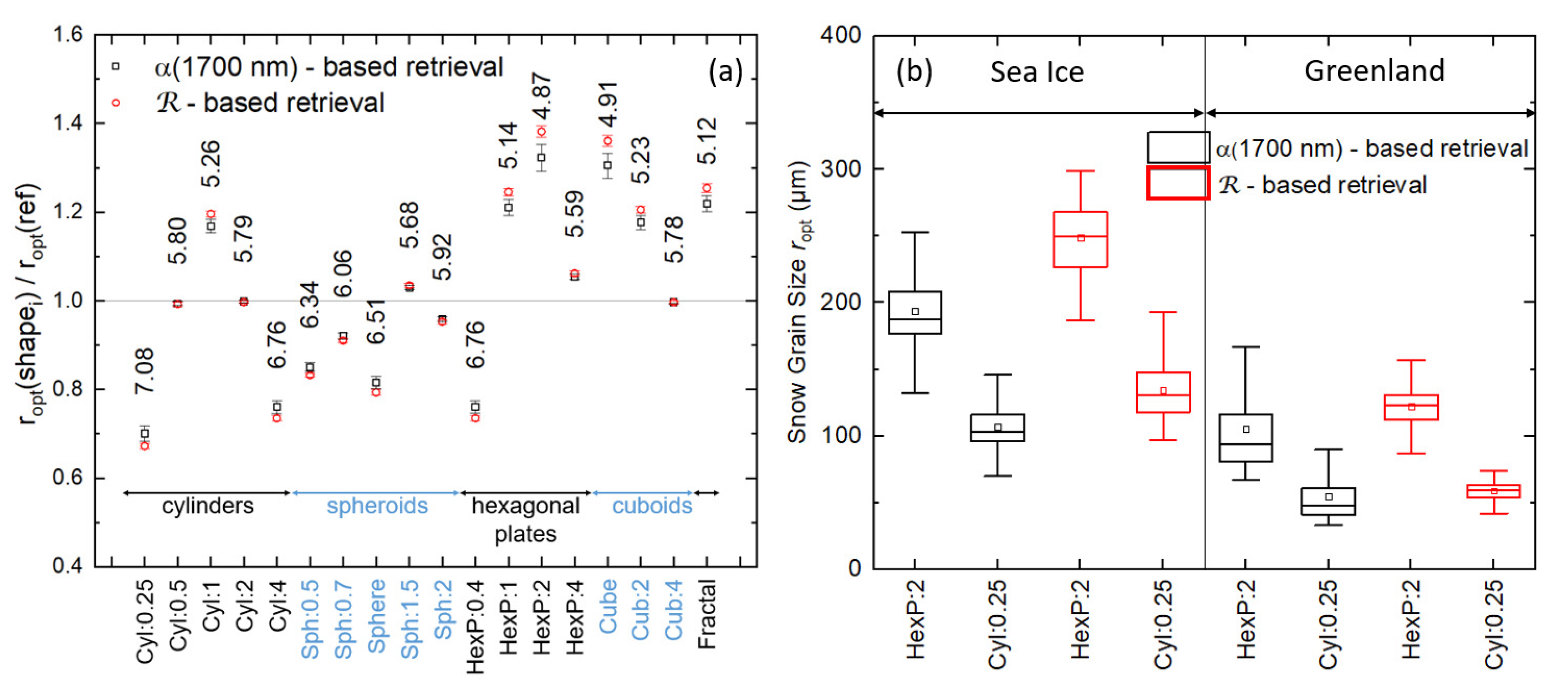
Publisher’s Note: MDPI stays neutral with regard to jurisdictional claims in published maps and institutional affiliations. |
© 2021 by the authors. Licensee MDPI, Basel, Switzerland. This article is an open access article distributed under the terms and conditions of the Creative Commons Attribution (CC BY) license (https://creativecommons.org/licenses/by/4.0/).
Share and Cite
Jäkel, E.; Carlsen, T.; Ehrlich, A.; Wendisch, M.; Schäfer, M.; Rosenburg, S.; Nakoudi, K.; Zanatta, M.; Birnbaum, G.; Helm, V.; et al. Measurements and Modeling of Optical-Equivalent Snow Grain Sizes under Arctic Low-Sun Conditions. Remote Sens. 2021, 13, 4904. https://doi.org/10.3390/rs13234904
Jäkel E, Carlsen T, Ehrlich A, Wendisch M, Schäfer M, Rosenburg S, Nakoudi K, Zanatta M, Birnbaum G, Helm V, et al. Measurements and Modeling of Optical-Equivalent Snow Grain Sizes under Arctic Low-Sun Conditions. Remote Sensing. 2021; 13(23):4904. https://doi.org/10.3390/rs13234904
Chicago/Turabian StyleJäkel, Evelyn, Tim Carlsen, André Ehrlich, Manfred Wendisch, Michael Schäfer, Sophie Rosenburg, Konstantina Nakoudi, Marco Zanatta, Gerit Birnbaum, Veit Helm, and et al. 2021. "Measurements and Modeling of Optical-Equivalent Snow Grain Sizes under Arctic Low-Sun Conditions" Remote Sensing 13, no. 23: 4904. https://doi.org/10.3390/rs13234904






